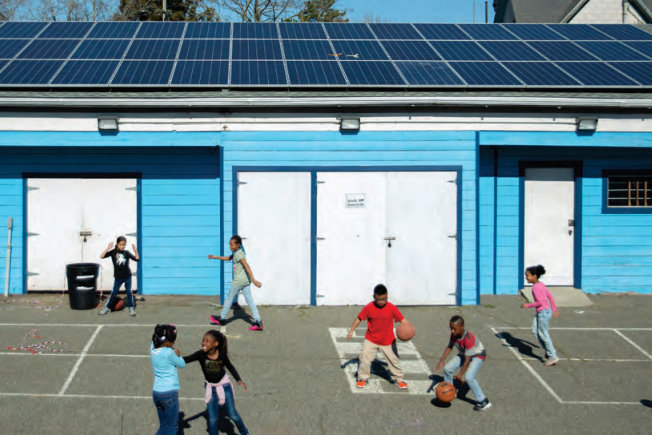Solar energy can reduce electricity costs and attract further investments, yet disadvantaged communities chronically lack access to the booming solar economy. Financing challenges, limited policy vehicles to support project development, and other obstacles put it out of reach of many working families. A new report takes an evaluative look at policies and projects across the country, including 11 case studies, and it draws out lessons learned to guide the implementation of solar in under-resourced communities to ensure long-term economic, equity, and public health benefits.
The Solar with Justice: Strategies for Powering Up Under-Resourced Communities and Growing an Inclusive Solar Market report is authored by a coalition of clean energy and environmental justice advocates, as well as academic and foundation partners. The report looks at solar projects across the U.S. and shares detailed insights from experts, including recommendations to:
- Minimize financial risks for low and moderate income (LMI) households: These households need guaranteed savings because they often do not have a cushion to withstand financial setbacks.
- Create partnerships with trusted community organizations: Local groups can best assess ways to meet community needs and actively engage.
- Increase financing options: Broad, effective funding is crucial to building out solar economies in underserved communities that lack financial resources.
- Bolster consumer protections: Leaders must provide education to ensure that LMI customers experience tangible benefits from solar.
The report offers detailed recommendations for community organizations, government entities, foundations, and the solar industry on practical approaches to place equity at the center of solar development. The case studies of model projects gathered from around the country also illustrate concrete actionable lessons learned that can be applied to solar development on a wider scale.
“Access to the benefits of a solar economy should be made available to everyone, not just a select few,” said Chandra Farley, Just Energy Director of the Partnership for Southern Equity. “But paying attention to the experiences and unique needs of under-resourced communities is critical to ensure projects are successful.”
The Solar with Justice report gathered perspectives from more than 90 experts across industry. It is the first of its kind to assemble a diverse team to explore solar in under-resourced communities, focusing on the voices and insights from community organization leaders across the U.S., and presenting concrete, actionable recommendations.
“The report zeroes in on how critical it is for foundations to prioritize an economic equity analysis not just in their grant-making, but also as they explore other financing mechanisms for inclusive solar development like mission related investing,” said Danielle Deane-Ryan, Director of the Inclusive Clean Economy Program at The Nathan Cummings Foundation. “It is vital to incorporate input from under-resourced communities.”
One key? Community empowerment
Community empowerment is the process of building leadership capacity within a community to
increase community-led decision-making. It is not enough to turn decision-making over to community
organizations and residents if they do not have the resources and subject-matter knowledge to deal
with a technically complicated subject like solar development, or if legal and financial barriers prevent
them from being positioned as solar project beneficiaries. The elements of creating community
empowerment can include the following:
1. Establishing trust
2. Educating the community
3. Building organizational capacity and developing leadership
4. Addressing barriers and biases
5. Involving relevant stakeholders in constructive engagement
6. Increasing community wealth
7. Mobilizing resources for program sustainability
Top Ten General Findings and Recommendations (Chapter 4)
- Partnerships involving trusted community organizations are essential
- It’s still the experimental phase for LMI solar
- Installations for community institutions deserve special consideration
- Resilience should be a component of LMI solar
- Financial risk needs to be minimized for LMI households and community organizations
- Strong consumer protection is crucial
- Shared solar projects can play a useful role, but they are not a panacea
- Training and workforce development should remain a priority
- Solar education is important
- Increasing the availability of financing for solar projects in under-resourced communities is essential
“Innovative solar projects focused on serving low-to-moderate income communities, especially people of color, will ensure that affordable, clean, and resilient energy is accessible to all,” said Rudi Navarra, Director of Investments at The Solutions Project. “Investors must recognize the social and market benefits. Communities that are most vulnerable to pollution, service disruption, and high electricity costs – from Native lands to urban areas to rural service territories – are able to determine their own energy fate.”
The report was authored by a diverse project team that included the Clean Energy States Alliance, Jackson State University Department of Urban and Regional Planning, Partnership for Southern Equity, PaulosAnalysis, University of Michigan School for Environment and Sustainability, the Nathan Cummings Foundation, and The Solutions Project.
— Solar Builder magazine


Leave a Reply
You must be logged in to post a comment.